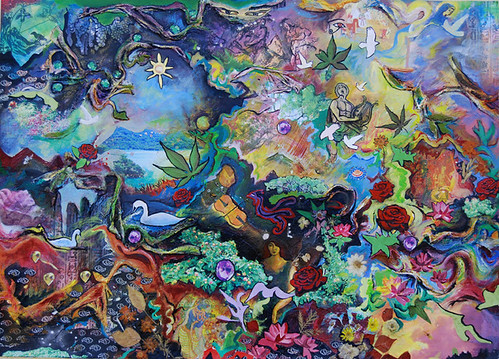 |
RI YUE TANG - Sun Moon Lake
This is the first piece of art I ever purchased. I fell in love with it when I saw it. I was completely captivated and stared at it for hours fascinated. It was the first time art had moved me in this way. I found it when I was logged into a virtual reality program called Second Life. I bought it in a store for my home there. For a short time I had a home in Second Life on a sim that looked similar to Lake Tahoe in California.
The reason I love this piece so much is because every time I look at it I see something different. I think the story behind Sun Moon Lake makes it even more interesting. I found the story on travel guide website for China.
|
"Sun Moon Lake is located in Nantou County, Taipei City. It is surrounded by Mount Shuishe and Mount Dajian. The lake covers an area of 7.7 square kilometers and has an average water depth of 40 meters. The lake is divided into northern and southern sections by an island called Guanghua. The lake gets its name because the northern section resembles a rhombus-shaped sun while the southern section looks like a crescent-shaped moon.
According to legend, a white deer contributed to the discovery of the lake. Three hundred years ago, a group of peasants were hunting when they discovered a large white deer running to the northwest. They followed this amazing creature for three days and nights, but it finally disappeared in the forest. On the fourth day, after they had moved through the forest, they came upon an impressive vista. They saw rolling verdant mountains and a shimmering lake shining brightly under the sun. A small round island covered with trees divided the lake into two parts. One part was like the sun and the other part was like the moon, so they called it Sun Moon Lake. Attracted by the fertile soil and beautiful scenery there, the peasants decided to settle down and began a new life.
Originally called Shui Shalian and Long Lake, the Sun Moon is the largest natural lake in Taiwan. The climate in this area is quite temperate with the highest summer temperature being less than 22 C (71.6
C (71.6 F) and the lowest winter temperature bottoming out at 15
F) and the lowest winter temperature bottoming out at 15 C (59
C (59 F). With such a pleasant climate, it is a top choice as a summer resort. Besides the cool weather, visitors are drawn by the magnificent scenery. The beauty of the lake lies in its tranquil crystal water that clearly reflects the surrounding mountains. Rain or shine, winter or summer, the lake offers visitors a plethora of picturesque sights. If the scenery of the lake were a wall calendar amazing and breathtaking pictures would be found by turning over each page. The lake is extremely attractive at night. When the water is bathed in moonlight tinged with a layer of thin fog, it gives the appearance of a place existing only in legend.
F). With such a pleasant climate, it is a top choice as a summer resort. Besides the cool weather, visitors are drawn by the magnificent scenery. The beauty of the lake lies in its tranquil crystal water that clearly reflects the surrounding mountains. Rain or shine, winter or summer, the lake offers visitors a plethora of picturesque sights. If the scenery of the lake were a wall calendar amazing and breathtaking pictures would be found by turning over each page. The lake is extremely attractive at night. When the water is bathed in moonlight tinged with a layer of thin fog, it gives the appearance of a place existing only in legend.
Many places of interest are found around the lake. Wenwu Temple, located near the north shore of the lake, pays homage to Confucius (551-479 BC), the founder of Confucianism. It also honors General Yue Fei (1103-1142) of the Southern Song Dynasty (1127-1279) and Guan Yu, a great general of Shu States in the Three Kingdoms (221-263). The temple is tall and splendid and is designed according to the features of the surrounding mountains. Guanghua Island is the burial place of Xuan Zang (602-664), the monk who went to India on foot to seek the sutra. Finally, on the island, there is a pavilion named for Old Man under the Moon (the god of marriage)."
